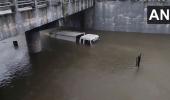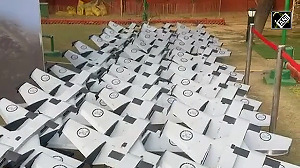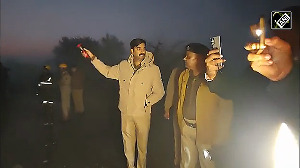For the Stalin government to win back the confidence of voters ahead of the Lok Sabha polls, post-flooding restoration works, their speed and efficacy would be closely watched, and not just by the political Opposition, notes N Sathiya Moorthy.

For the third time in eight years, Chennai residents saw their homes going under rain-fed floods with no succour coming their way when they needed it the most.
Needless to say, they blamed it all on the state government and the Greater Chennai Municipal Corporation on social media, with memes, at times politically-motivated, targeting Chief Minister M K Stalin, especially on his government's pre-cyclone declaration that the Rs 4,500 crore (Rs 45 billion) drainage improvement schemes would bear fruit in the worst of times.
Looking back, the first major rains and floods in the current century in the Tamil Nadu capital was recorded in October-November 2005.
That was when the nineties' kids and their parents in the districts sort of celebrated the plight of Chennaiites, who were seen crossing the arterial Anna Salai aka Mount Road, in fishing boats, brought in by the authorities.
People in the districts were content with the fact the urban elite were put to the kind of hardships and difficulties that they (alone) had been experiencing through the rainy season, year after year.
There was, however, a difference. In some cases, people in the coastal districts of south and south-central Tamil Nadu have rains from both the south-west monsoon (June-September) and the north-east monsoon (October-December).
Some districts get it only in the south-west monsoon season.
When both rains are timely and moderate to good, it is a boon for the farming community. When it lashes out endlessly, then it is distress and disaster coming together.

In comparison, pickled in a rain-shadow region, Chennai gets rains, if at all, only from the north-east monsoon, especially from cyclonic storms of that which lashed the city and adjoining districts these past days.
If one has to make a learned guess, then the frequency and severity when it hurts, has only increased in the past decade and more.
The current problems of Chennai, originally Madras, owes to its geographical location as a rain-shadow region.
Seasonal rains were erratic at best, and cyclonic storms sort of became the mainstay.
Even the summers were harsh as drinking water was always in scarcity.
The British East India Company still chose it as its first capital in 1639, before shifting to Calcutta, now Kolkata, only because originally they were looking only for a relatively peaceful sea-front without interference from local rulers, for setting up a 'factory', or go-down, to stock locally-procured textile goods for exports back home.
History has its own ways, and what soon became a network of stand-alone villages dating back to a thousand years and more, and connected by paddy fields, mango and coconut groves, became a city first, a metropolis later, and megapolis in this century.
The explosion of the city since the advent of economic reforms in the early nineties has been unprecedented, as the ubiquitous IT industry developed on its own without the so-called governmental support offered in H D Deve Gowda-ruled Bengaluru and Hyderabad, which under then chief minister Nara Chandrababu Naidu came to be rechristened as Cyberabad.
The Velachery-Perungudi-Sholinganallur belt in the city's south, housing the IT industry and their upmarket professionals in their tens of thousands, sprouted up on its own -- on marshy lands, whether legit or illegal constructions on encroached lake-beds.
As coincidence would have it, they have been receiving the worst of rains through the past decade.
This time, it was 50 cm in 36 hours, a record for 70-80 years.
It is also in these parts, and along the adjoining OMR/ECR road-front that Chennai's multi-storeyed apartments, gated communities, and mini-cities, apart from office blocks have come up over the past two-plus decades, going up to 15-20 floors against the 1+3 standard set for the rest of the city until then.
Even inter-linked old localities like Mambalam, Nungambakkam and T Nagar used to be a huge lake until about a hundred years back.
Less said about North Madras, where the cities poor and labour class used to live, but it has also been getting a lot of face-lift in recent years, and also relatively better civic infrastructure like drainage that were not there even a decade back.
Once cursed North Madras is already competing for the city's resources for infrastructure development, and that is another story.

For a 'doubly-cursed' city that takes big hits both during the summer (water shortage), monsoon (flooding on occasions), civic infrastructure or lack of it is only one of the problems.
So is unplanned construction, whether legal or not.
Barring Gandhinagar, Chandigarh and a few other cities and towns elsewhere, the rest of them all have had an organic evolution, their vertical and horizontal expansion dictated by their potential for job creation, attract and house blue-collar labour, white-collar employees and high-end technocrats and managers.
Chennai's has been a similar story. In the pre-Independence era, they all came from all corners of the Madras Presidency.
There was a relative lull in the post-Independence period, but it has spiked exponentially since the spurt in IT and higher education industries, as the city produces the highest number of engineering graduates year after year -- requiring land, construction and accommodation.
This has also meant that non-Tamil grey and blue-collar workers and also technocrats and management personnel from across the country have descended on the city as never before.
It has created its own problems for the civic authorities that can be rectified only by education and acceptance.
This year, for instance, days before the cyclone formation, the state government issued public statements, appealing to people in areas expected to be affected by storm-winds and flooding, to store essentials in advance, and provide for the authorities disconnecting power supply to avoid accidental electrocution.
This has been the norm across the state over the past two decades or so.
As announced, the moment the rains stopped on Monday night, power supply was restored in phases, after checking for possible leakages.

Yet, for the IT sector generation, especially those from outside the state, Chennai is already the 'disaster capital of India'.
It began with the end-2004 tsunami that hit the city's shore-front, taking its toll in human lives, followed by the 2005 rains and floods.
Either that generation had got out of the psyche or had moved onto other jobs in other cities and countries, but the heavy rains in 2015 and Cyclone Wardha the very next year rattled the city as badly, the fears and sentiments too returned.
Now, that psyche seems to have crystallised, though it is also this 'google generation' that should have learnt about the way the US, their favourite destination, messed around and unbelievably so with the after-effects of Hurricane Katrina in August 2005.
In retrospect, however, it was this IT generation and their brother-youth that rose to the occasion, to rush help to those hit by the midnight flooding in 2015.
That flooding was caused by the delayed governmental decision and unannounced midnight release of excess water flowing into the suburban Chembarambakkam reservoir that otherwise quenches the thirst of Chennai city.
In comparison, this time round, water releases from this and other reservoirs were pre-planned and happened only after people living in low-lying areas were removed to the safety of temporary corporation shelters, put up invariably in neighbourhood schools.
Yet, the test of the pudding is in the eating.
For the Stalin government to justify the high-spending on flood-safety measure, and win back the confidence of the voters in the city and adjoining affected districts ahead of the Lok Sabha polls next year, post-flooding restoration works, their speed and efficacy would be closely watched, and not just by the political Opposition.
For the present, however, the latter have had a field day in criticising the government as inefficient and corrupt.
But the fact remained that owing to unprecedented rainfall this time, the expanded drainage network still became inadequate to carry the accumulated water on the roads and streets.
With the rains having stopped already, the government's efficiency in pressing all those emergency staff-pools about which it had tom-tommed earlier, to put the city back on its feet quick and fast is what will make the difference, and not just in the Lok Sabha polls.
That and that alone will erase the image of Chennai as the 'disaster capital', propagated at times assiduously by a generation that actually feels that way, but whose parental generation across the Vindhyas may have political reasons to propagate the imagery even more.
N Sathiya Moorthy, veteran journalist and author, is a Chennai-based policy analyst and political commentator.
Feature Presentation: Aslam Hunani/Rediff.com










